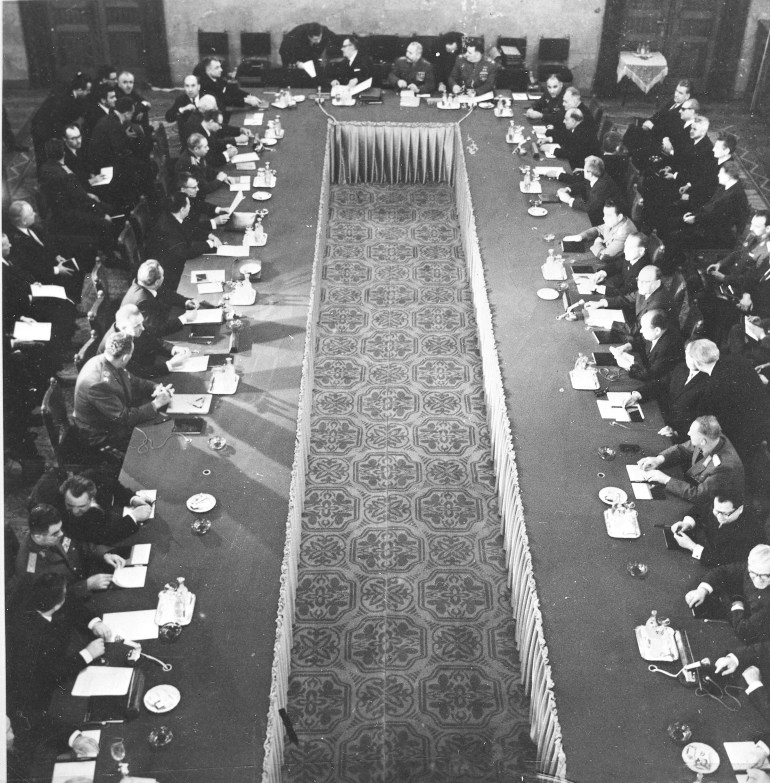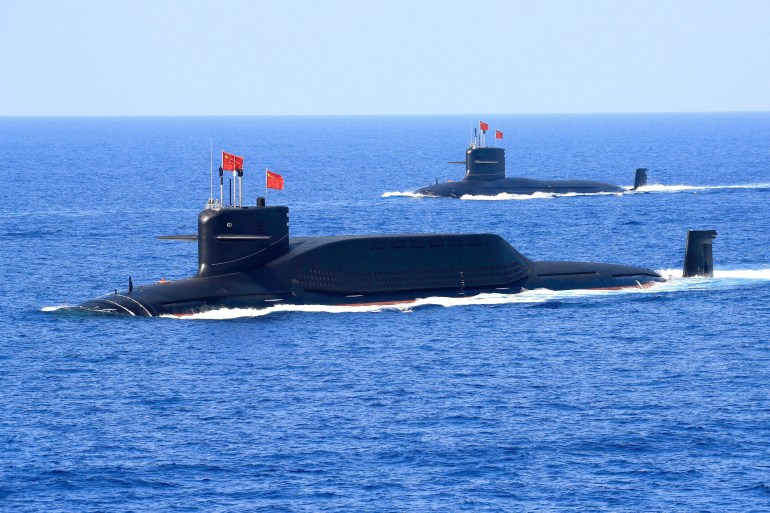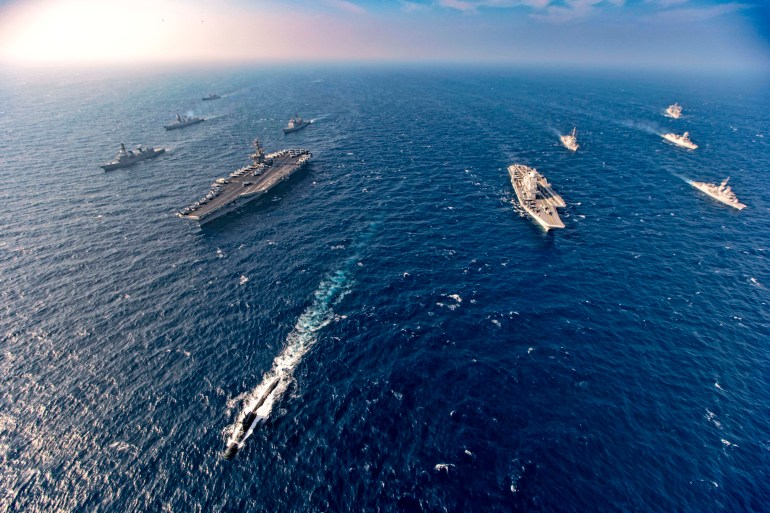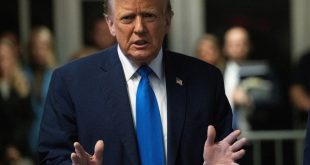It is the largest military alliance on the planet, it is more than 70 years old and, for many within NATO (the North Atlantic Treaty Organisation), it is only just getting going.
A Cold War creation, NATO was established in 1949 as a bulwark against the colossal Soviet armies based in Eastern Europe in the wake of the Second World War.
This system of US-led collective security, initially consisting of 10 Western European countries, Canada and the United States, helped avert any thoughts by the Soviet Union (USSR) of expanding further westward, helping maintain an uneasy, tension-fraught peace in Europe for decades.
 Secretary of State Dean Acheson signs the Atlantic defence treaty for the United States on April 4, 1949, as Vice President Alben W. Barkley, left, and President Harry Truman watch on [File: AP Photo]
Secretary of State Dean Acheson signs the Atlantic defence treaty for the United States on April 4, 1949, as Vice President Alben W. Barkley, left, and President Harry Truman watch on [File: AP Photo]
But NATO has struggled to redefine its role and relevance since the collapse of the Soviet Union in 1991, despite expanding its domains to include outer space and cyberspace, and recently refocussing some of its attention on its old nemesis, Russia.
It now also extends far beyond Europe, past Iraq and Afghanistan, to its new main concern, China.
Noble beginnings
In the years following World War II, NATO evolved from a desire among European nations to protect themselves from any further aggression that might, once again, engulf the continent.
Europe lay in ruins, its economies shattered, its resources and manpower depleted. Two superpowers had emerged from the war, the United States and the USSR. Joseph Stalin, ruler of the Soviet Union, had quickly assimilated most of Eastern Europe. Collective security for Western Europe, under the aegis of the United States, seemed the perfect solution. The North Atlantic Treaty Alliance was thus born in 1949 out of fear of Soviet intimidation and its potential for westward expansion. America had lost nearly 400,000 lives in the war but its economy and industries were thriving, giving it the fiscal clout not only to keep its own large standing of armed forces but to help those of Western Europe.
While the emergence of NATO certainly helped ease European nations of their fears of another major conflict, the continent would nevertheless become the arena for the opening stages of what could become a nuclear war in a matter of hours, if not days.
Increasingly concerned by the growth of NATO, the Communist Eastern Bloc in turn looked to form its own system of collective security. In 1955, the Warsaw Pact was formed by the Soviet Union and seven Eastern European countries, spurred on partly by West Germany joining NATO earlier that year.
 Soviet leaders draft a treaty to establish a unified military command to rival NATO in the parliament building in Warsaw, Poland on May 14, 1955. From left to right: Soviet Marshal Ivan Konev, supreme commander of the alliance; Vyacheslav M. Molotov, Soviet foreign minister; Premier Nikolai Bulganin; and defence minister Georgi Zhukov [File: AP Photo]
Soviet leaders draft a treaty to establish a unified military command to rival NATO in the parliament building in Warsaw, Poland on May 14, 1955. From left to right: Soviet Marshal Ivan Konev, supreme commander of the alliance; Vyacheslav M. Molotov, Soviet foreign minister; Premier Nikolai Bulganin; and defence minister Georgi Zhukov [File: AP Photo]
Both sides had integrated nuclear weapons into all levels of their tactical and strategic thinking. To illustrate how extensive the use of nuclear weapons was, the Czech army for example, although only a minor Warsaw Pact country, had plans to launch more than 80 nuclear weapons at ports, marshalling yards and troop concentrations in the event of a major conflict.
By the mid-1960s, similar plans were held by most of the major NATO and Warsaw Pact countries. With the real danger of Europe being reduced to radioactive rubble, a brutal impasse emerged, with the tacit understanding that any overt military act against another military would end in catastrophe for everyone concerned. It is in this risk-averse environment that NATO operated, with success throughout the Cold War period.
Russian fear of encirclement
Yet despite the collapse of Communism, the crumbling of the Soviet Union and the subsequent dissolution of the Warsaw Pact in 1991, NATO kept going. Instead of being dissolved – as there was no longer any Soviet Union to contain – NATO expanded, going from 16 to 30 member states following the Soviet collapse.
Former rivals from the Warsaw Pact, in fact most of Eastern Europe, were absorbed into a Western alliance whose mandate was to protect itself from Russia and limit its expansion. From a Russian point of view, this felt like containment all over again. The Alliance was repeatedly warned that Russia would not tolerate any of the states bordering its territory becoming members.
To understand how alarmed Russia is by NATO’s expansion east, imagine how the United States would feel if Canada and/or Mexico had become members of the Warsaw Pact. An intolerable notion for the US, with much justification.
This Russian fear of encirclement is one of the many reasons the conflict in Eastern Ukraine continues to smoulder. Ukraine has repeatedly asked to join NATO but it is in NATO’s charter not to accept any new member state that is involved in an existing conflict. Tacit Russian military involvement and the subsequent fighting in Donetsk effectively bars Ukraine from membership of the Alliance.
 Delegations from seven European Communist countries at the summit meeting of the Warsaw Pact, on March 17, 1969, in Budapest, Hungary [File: AP Photo]
Delegations from seven European Communist countries at the summit meeting of the Warsaw Pact, on March 17, 1969, in Budapest, Hungary [File: AP Photo]
Furthermore, hard lessons were learned by Russia in the brushfire conflicts of Chechnya in the 1990s and Georgia in 2008. Despite eventual Russian victories, the conflicts exposed crucial deficiencies in tactics and training. It was clear that Russia’s armed forces were poorly equipped and did not have the training to leverage military technology to their advantage, as Western military forces had.
Russia sought to benefit from its past mistakes and adapt effectively to modern warfare, leading it to embark on a crash modernisation programme, increasing investment and focusing on a smaller, more professional army that is far better trained and equipped.
The real reason for joining NATO – members with benefits?
The clash of ideas between NATO and the Warsaw Pact has always been painted as democracy versus authoritarianism, as well as the notion that the NATO of today is a confluence of like-minded democratic ideals and of shared values.
A great idea, but it flies in the face of reality. Blind eyes were turned when the Greek and Turkish militaries overthrew their respective civilian governments during the Cold War in the 1960s. More recently, very little action has been taken by NATO member states over the Hungarian and Polish governments’ increasing lack of tolerance for political dissent, as they slide dangerously towards autocracy.
For the most part, the premise that NATO upholds an ideal of democracy may be true, however, the exceptions are ignored, especially if the countries concerned are in strategic locations, such as Poland, which borders Kaliningrad, a Russian exclave, and Belarus, a Russian strategic ally.
While the NATO alliance affords a good measure of protection by deterring any thought of military action against a member state, that is not the only reason to join. Other reasons are the tangible military benefits that member states will receive and the political, military and logistical leverage provided by the US that is so useful and so sought after – namely the soft side of American hard power.
The United States has wielded this vast power for decades, not just in obvious military capabilities but in the areas in which most European nations are lacking: Intelligence gathering; logistical supply chains; strategic transport aircraft; helicopters and a vast body of military expertise and know-how that would simply cost too much for most nations to reproduce. In return, the US gets the right to establish military bases in these countries and is able to influence each country’s strategic thinking to a certain degree, comfortable with the notion that most countries would choose to follow a path laid out by the United States rather than opt out of the Alliance altogether.
 Citizens of West Berlin hold a vigil on the Berlin Wall on November 10, 1989 [File: Stringer/Reuters]
Citizens of West Berlin hold a vigil on the Berlin Wall on November 10, 1989 [File: Stringer/Reuters]
Although critics of NATO focus on the pre-eminence of the US, imagine how NATO would fare without the help of the United States. Just over a decade ago, on June 10, 2011, the then US defence secretary Robert Gates stood in front of his NATO colleagues and assembled European dignitaries in what was his last major policy speech. In it, he berated the Alliance and castigated the Europeans for their lack of foresight, ineptitude and reliance on America’s endless help. The war in Afghanistan had exposed NATO’s shortcomings in being able to maintain 25,000 to 40,000 troops there, despite collectively having more than 2 million non-US personnel at its disposal.
Gates was especially blunt when it came to the recently unfolding conflict in Libya. It is worth quoting some of the extracts from his speech, entitled Reflections on the Status and Future of the Transatlantic Alliance:
“…while every alliance member voted for [the] Libya mission, less than half have participated at all, and fewer than a third have been willing to participate in the strike mission. Frankly, many of those allies sitting on the sidelines do so not because they do not want to participate, but simply because they can’t. The military capabilities simply aren’t there … Furthermore, the mightiest military alliance in history is only 11 weeks into an operation against a poorly armed regime in a sparsely populated country – yet many allies are beginning to run short of munitions, requiring the US, once more, to make up the difference.”
He went on to draw a sharp line under the point made that Europeans need to do more – a lot more – if they want the United States to continue to support the NATO Alliance:
“Indeed, if current trends in the decline of European defence capabilities are not halted and reversed, future US political leaders – those for whom the Cold War was not the formative experience that it was for me – may not consider the return on America’s investment in NATO worth the cost.”
 US Secretary of State Antony Blinken, right, and and NATO Secretary General Jens Stoltenberg arrive for a news conference during a meeting of NATO foreign ministers at NATO headquarters in Brussels, on March 23, 2021 [File: Yves Herman, Pool via AP]
US Secretary of State Antony Blinken, right, and and NATO Secretary General Jens Stoltenberg arrive for a news conference during a meeting of NATO foreign ministers at NATO headquarters in Brussels, on March 23, 2021 [File: Yves Herman, Pool via AP]
Yet, despite Gates’s frankness, very little was actually done by Europeans who were also going through their own fiscal convulsions as the global financial crisis of 2007-2008 made itself increasingly felt in all walks of life.
It took the mercurial Trump administration to finally push member states to pledge they would increase their own defence spending, relieving some of the burden on the United States, whose focus was increasingly on a newly invigorated China, its military expansion now causing great alarm for both the West and the US’s Asia-Pacific allies.
Pivot east
NATO has justified its new focus on China as a “collective defence” against what it views as Chinese encroachment on European interests.
Key ports, such as the Port of Piraeus in Greece, one of the largest in Europe, are now majority-owned by Chinese companies, as they have sought to buy up commercially strategic properties for sale that could benefit China.
Added to this are increased Chinese naval patrols in the Atlantic and China’s rising interest in the Arctic as well as the economic viability of the Northeast Passage over the top of Russia. This new route, just recently made possible by the thawing of Arctic ice sheets, has the potential to save thousands of kilometres on every commercial voyage to and from northern Asian countries such as Japan, South Korea and China.
This increased activity in Europe, coupled with extensive cyberattacks on Western commercial and military targets that the Alliance says bear the hallmarks of the Chinese state, have many NATO nations worried.
China is not doing anything wrong by investing in its own economic needs and logistics. It has bought sites that were already up for sale. It is operating in its own interests, as all countries do. But crackdowns on political dissent at home, together with an increasingly capable military have made many European states nervous about what comes next, if China’s interests are eventually crossed.
 A nuclear-powered Type 094A Jin-class ballistic missile submarine of the Chinese People’s Liberation Army (PLA) Navy is seen during a military display in the South China Sea on April 12, 2018 [File: China Stringer Network/Reuters]
A nuclear-powered Type 094A Jin-class ballistic missile submarine of the Chinese People’s Liberation Army (PLA) Navy is seen during a military display in the South China Sea on April 12, 2018 [File: China Stringer Network/Reuters]
This fear is amplified by the authoritarian state’s military-civilian fusion in many areas. In the South China Sea, there are large fleets of ships – allegedly Chinese fishermen attempting to make a living but which are, in fact, directly under the control of the People’s Liberation Army (PLA). These fleets are often used to intimidate neighbours and stake de facto claims of Chinese ownership over the resource-rich waters of this strategically vital waterway. The latest incident was in March 2021 when more than 200 Chinese fishing vessels turned up in Whitsun Reef, an area of the South China Sea that both China and the Philippines claim.
How will NATO deal with all of this? How will it project power in any meaningful way that will resolve any potential Chinese transgressions? This is the challenge NATO now sees for itself as it enters this new and uncertain phase, during which there are many who think the Alliance has either outlived its usefulness or needs refocusing and that better institutions and alliances already exist to help US interests in the Indo-Pacific region.
As part of the United States’ pivot east to confront a rising China, it has increasingly invested in the Quadrilateral Security Dialogue, better known as the Quad. Established in 2007, it is made up of the US and regional allies – Japan, India and Australia. Initially a paper organisation, over the past few years it has become an alliance of growing cohesion and potency, as the navies of all four countries train extensively and seek to become more integrated.
 Aircraft carriers and warships participate in the second phase of a joint naval exercise between India, the US, Japan and Australia on November 17, 2020. The four countries form the Quadrilateral Security Dialogue, or the Quad [File: Indian Navy via AP]
Aircraft carriers and warships participate in the second phase of a joint naval exercise between India, the US, Japan and Australia on November 17, 2020. The four countries form the Quadrilateral Security Dialogue, or the Quad [File: Indian Navy via AP]
The basic fact is, if the US wants to contain China, it is going to need to co-opt Asia-Pacific powers into helping it do just that, in much the way the Soviet Union was contained. The difference being the Soviet Union had nowhere near the economic might China – fast on track to becoming the world’s biggest economy – has today.
Desperately seeking relevance
NATO has been struggling with its ever-evolving identity since the end of the Cold War. Born from a desire for collective defence and containment of the USSR, its mandate morphed to include nation-building, peace-keeping, military-civil relations and the never-ending fight against terrorism and organised crime, with varying degrees of success.
The original brief – that of European collective security – has been re-invigorated by Russia’s military modernisation. In 2014, the bloodless assimilation of Crimea into Russia, despite it being overwhelmingly ethnically Russian, sent shockwaves through NATO, especially among those who are Russia’s neighbours and who feel increasingly nervous that this “assimilation” might one day soon be used on them.
This has given the Alliance some of its traditional focus back as collective security within Europe shifts east from Germany and the old East-West partitions to the new fault lines dividing the increasingly worried Baltic States and Poland from a resurgent Russia.
Throughout its history, NATO has always been a fractious Alliance. The attempts to consider the national wants and needs of all its member states at times seem an impossible task. Sometimes the desire by a member state for military independence and the leeway to act in its own interests wins the day.
Key ally and nuclear state France left in 1966, only to return, under certain conditions, decades later in 2009.
Turkey, a vital member of the Alliance, has recently involved itself in conflicts on its doorstep in Syria and as far away as Libya. In these messy civil wars, often fought by proxies, NATO members have at times found themselves on opposing sides – the complicated network of temporary alliances shifting with remarkable speed.
It is in this climate that NATO now has to operate – not faced, as during the Cold War, with one clearly defined adversary, but fighting a patchwork of local conflicts while maintaining an ever-growing alliance between countries all with their own strategic considerations. It is little wonder that NATO is still struggling to define itself.
 Top Naija News: Nigerian News, Breaking News Nigeria and World News Top Naija News is a daily news publication in Nigeria, delivering the latest breaking news in Nigeria and around the world.
Top Naija News: Nigerian News, Breaking News Nigeria and World News Top Naija News is a daily news publication in Nigeria, delivering the latest breaking news in Nigeria and around the world.



